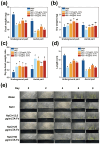Tannic acid-iron nanomaterial enhances rice growth and antioxidant defense under salt stress
- PMID: 40718030
- PMCID: PMC12289653
- DOI: 10.3389/fpls.2025.1565234
Tannic acid-iron nanomaterial enhances rice growth and antioxidant defense under salt stress
Abstract
Salinity stress severely impacts plant growth by reducing water uptake and biomass accumulation, while nanomaterial applications have emerged as effective solutions. This study introduces tannic acid-iron nanomaterial (TA-Fe Nanomaterial), a biocompatible nanomaterial synthesized via self-assembly, as a novel solution to mitigate salt stress. Characterized by lamellar morphology (200 nm average size) and robust thermal stability, TA-Fe Nanomaterial demonstrated potent reactive oxygen species (ROS) scavenging capabilities. Under 100 mM NaCl stress, applying 25 μ g/mL TA-Fe Nanomaterial enhanced rice seed germination, increasing root length by 85% compared to salt-stressed controls. In the hydroponic experiment, treated seedlings exhibited 70% and 87% increases in underground and aboveground lengths, alongside 133% higher fresh weight. Soil-cultivated rice showed 43-88% improvements in biomass and 67% greater shoot length. Furthermore, applying TA-Fe Nanomaterial can alleviate the aberrant ROS accumulation in leaves under the conditions of salinity stress. These findings suggest that TA-Fe Nanomaterial could be a promising tool for enhancing rice tolerance to salt stress, paving the way for future applications in sustainable agriculture.
Keywords: nanomaterial; reactive oxygen species; rice; salt stress; sustainable agriculture.
Copyright © 2025 Cheng.
Conflict of interest statement
The author declares that the research was conducted in the absence of any commercial or financial relationships that could be construed as a potential conflict of interest.
Figures





Similar articles
-
Molecular Regulation of Antioxidant Defense and Metabolic Reprogramming in Xiaozhan Rice Genotypes: Differential Roles of Salicylic Acid and Melatonin Under Salt Stress.Curr Issues Mol Biol. 2025 Jun 7;47(6):432. doi: 10.3390/cimb47060432. Curr Issues Mol Biol. 2025. PMID: 40699831 Free PMC article.
-
Iron oxide nanoparticles (FeO-NPs) mitigate salt stress in peanut seedlings by enhancing photosynthesis, osmoregulation, and antioxidant activity.Plant Physiol Biochem. 2025 Jul 1;227:110206. doi: 10.1016/j.plaphy.2025.110206. Online ahead of print. Plant Physiol Biochem. 2025. PMID: 40614542
-
Enhancement of plant growth in lentil (Lens culinaris) under salinity stress by exogenous application or seed priming with salicylic acid and hydrogen peroxide.PLoS One. 2025 Jun 20;20(6):e0326093. doi: 10.1371/journal.pone.0326093. eCollection 2025. PLoS One. 2025. PMID: 40540484 Free PMC article.
-
Promotion of Ca2+ Accumulation in Roots by Exogenous Brassinosteroids as a Key Mechanism for Their Enhancement of Plant Salt Tolerance: A Meta-Analysis and Systematic Review.Int J Mol Sci. 2023 Nov 9;24(22):16123. doi: 10.3390/ijms242216123. Int J Mol Sci. 2023. PMID: 38003311 Free PMC article.
-
Salinity Stress in Rice: Multilayered Approaches for Sustainable Tolerance.Int J Mol Sci. 2025 Jun 23;26(13):6025. doi: 10.3390/ijms26136025. Int J Mol Sci. 2025. PMID: 40649804 Free PMC article. Review.
References
-
- Aguilera J. R., Venegas V., Oliva J. M., Sayagués M. J., Miguel M., Sánchez-Alcázar J. A., et al. (2016). Targeted multifunctional tannic acid nanoparticles. RSC Adv. 6, 7279-7287. doi: 10.1039/C5RA19405A - DOI
-
- Akanbi-Gada M. A., Ogunkunle C. O., Vishwakarma V., Viswanathan K., Fatoba P. O. (2019). Phytotoxicity of nano-zinc oxide to tomato plant (Solanum lycopersicum L.): Zn uptake, stress enzymes response and influence on non-enzymatic antioxidants in fruits. “Environmental Technol. Innovation 14, 100325-100325. doi: 10.1016/j.eti.2019.100325 - DOI
-
- Baker C. J., Mock N. M. (1994). An improved method for monitoring cell death in cell suspension and leaf disc assays using evans blue. Plant Cell Tissue Organ Culture 39, 7–12. doi: 10.1007/BF00037585 - DOI
LinkOut - more resources
Full Text Sources
Research Materials

